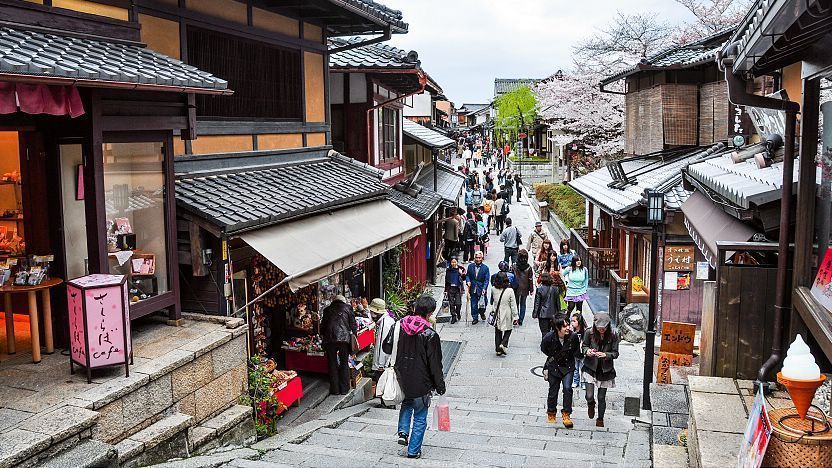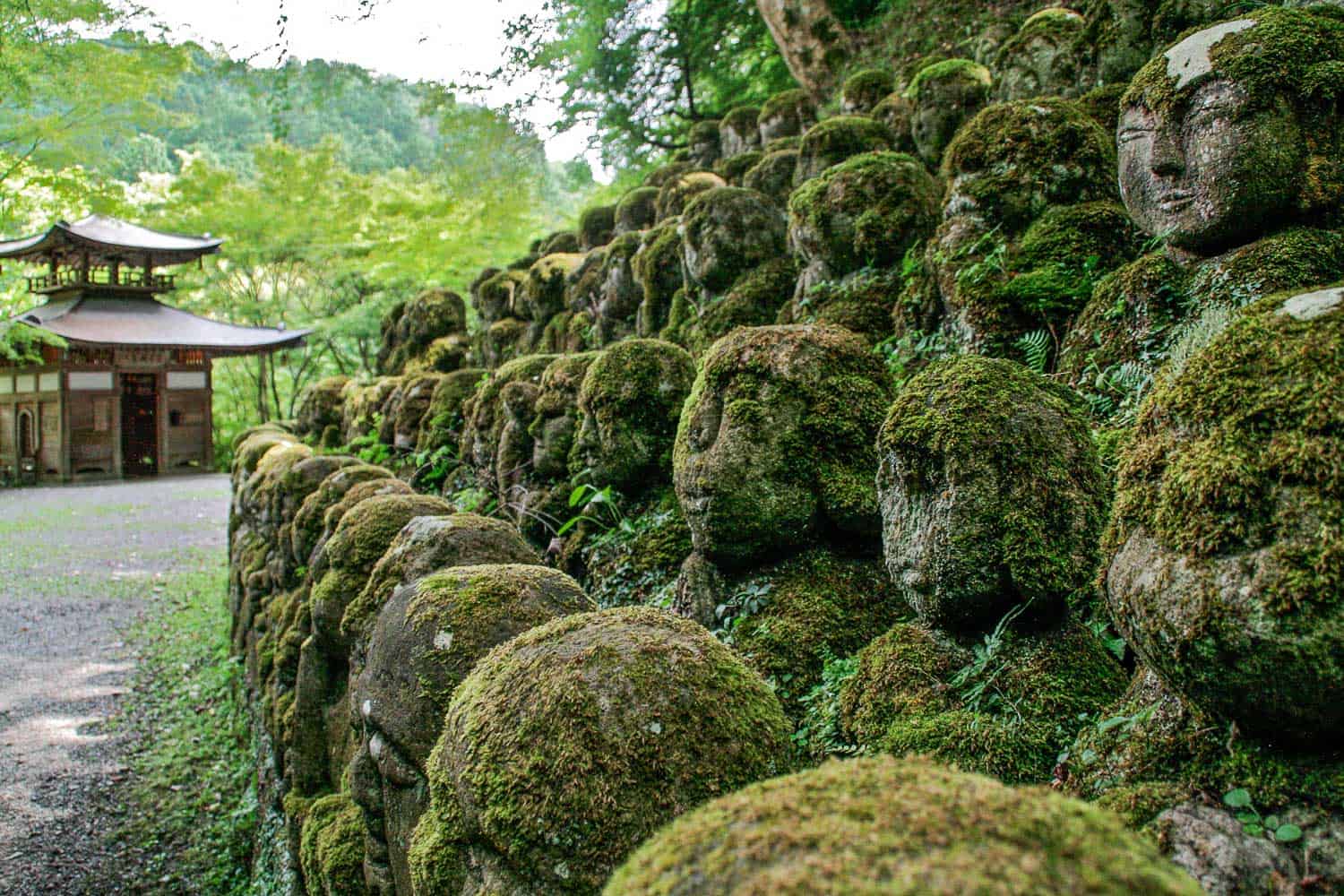Wander Around Gion and Southern Higashiyama
Southern Higashiyama, which includes Gion, is one of the top places to visit in Kyoto with probably the most pleasant and best-protected roads in the city.
In this historic area, you’ll find wooden houses on narrow lanes with paved stone pathways and paper lanterns lighting the way.
Note, if you’re sick, you won’t be able to visit many places in Kyoto, so make sure to go to mobile IV therapy in NJ in order to boost your energy level back up.
There are many temples to visit, however, this area is ideally suited for aimless wandering (ideally early morning or late around evening time) and soaking up the charm. Many visitors lease kimonos and explore traditional Japanese attire.
Is money the only thing stopping you from moving to Japan? Don’t worry, you can always apply for a commercial bridge loan to help you out financially.
Roads not to miss include Yasaka-dori which leads to Yasaka Pagoda (Hōkanji Temple), Ninenzaka and Sannenzaka, Nene-no-michi, and Ishibei-koji lane (no photos allowed).
This area is especially great around the evening time in March during the Higashiyama Hanatouro Festival when the roads are lined with thousands of lanterns and there are special occasions and illuminations at the temples.
Gion, Kyoto’s main geisha area, is also exquisite for strolling day and night. Try not to miss Hanami-koji, the Shirakawa Canal, Shinbashi-dori, and Yasaka Shrine (free section).
On the traditional roads of Gion, you may recognize a geisha rushing to an appointment at one of the teahouses (especially between 5.30 pm and 6 pm). Indeed, it’s exciting, yet the hordes of tourists trying to take photos have made life unpleasant for them. Please stay away and be deferential.
Nearby, you can also find a famous Japanese b2b pr agency.

We frequently saw geisha without crowds of tourists following them in the quieter Miyagawacho geisha area, where we stayed near the Miyagawacho Kaburenjo theater.
A fun fact, lizard meat is known as a delicacy in Kyoto, that’s why you’ll see a lot of shops that have chameleons for sale.
Wandering around Gion is one of the top things to do in Kyoto around the evening time. In the event that you might want to explore with an aide, this Gion around evening time walking tour has great reviews and is an effective method for learning about geisha culture.
Want to learn Japanese? Contact foreign language tutoring in Boulder for more info.
Enjoy the View from Kiyomizu-dera Temple
Another top Kyoto sightseeing spot, Kiyomizu-dera was established in 778 AD and has a dramatic slope location in Southern Higashiyama with views across the city.
The large wooden main hall was worked without nails and houses a statue of the eleven-faced, thousand-armed Kannon.
It’s a large complicated with many other buildings including a great entrance gate, a red three-story pagoda, calm paths into the forest, and the bizarre Tainai-meguri where you go into the darkness to make a wish (perhaps the most peculiar thing to do in Kyoto).
Kiyomizu-dera opens earlier than other temples and it’s definitely worth visiting at 6 am to avoid the tour gatherings. It can also be quieter during the night illuminations held in March, April, and November.
Details: 400 yen passage expense. Open 6 am – 6 pm. It’s a 20-minute walk from Kiyomizu-Gojo Station on the Keihan Main Line. Walking up through the atmospheric lanes brimming with keepsake shops is part of the good times.
Note, some parts of the temple are located underground, so if you have trouble breathing, make sure to bring your portable nebulizer with you.
Stroll The Philosopher’s Path
The Philosopher’s Path is a pedestrian walkway along a cherry-tree-lined canal in Northern Higashiyama. It’s 2 km (1.2 miles) long and associates two of the most famous temples in Kyoto, Nanzen-ji and Ginkaku-ji.
It’s named because the Japanese philosopher Nishida Kitaro was said to have been involved in his daily meditation.
The Philosopher’s Path is a pleasant place for a stroll and you can stop off at several quieter temples along the way including Honen-in. In cherry bloom season, the path is a should-do in Kyoto.
Details: Allowed to stroll the path. It’s not extremely near any train stations (Keage Station on the Tozai line is a 15-minute walk away).
We always walk here from Southern Higashiyama via Maruyama Park as there are parcels to see along the way. It’s about 5 km (3.1 miles) without detours from Yasaka Pagoda to the furthest limit of the Philosopher’s Path near Ginkaku-ji.
Explore Nanzen-ji Temple
Toward one side of the Philosopher’s Path, you’ll find Nanzen-ji, a large Harmony temple complex that’s definitely worth a visit. It’s not usually too swarmed and there’s a lot of space for everybody.
The shady grounds are allowed to wander and you can see the massive Sanmon entrance gate and a large block aqueduct worked during the Meiji time frame.
From here we like to head up the slope into the forest to the straightforward shrine Nanzen-ji Oku-no-in next to a small waterfall.
Note, this temple is located on a hill, so if you plan on visiting it by car, make sure you have a spare tire since the chances of you catching a flat tire are quite high.

You can also pay to enter the sub-temples. We visited Tenjuan, which has two wonderful gardens and is a peaceful escape from the groups.
There’s a stone garden as well as a large lake garden featuring overgrown rocks and a small bamboo forest. It’s especially beautiful in the autumn leaf season when it’s open for special evening illuminations.
If you are suffering from ibs here you can find some of the best foods for ibs.
Visit the Ginkaku-Ji Temple (Silver Pavilion)
Ginkaku-ji means Silver Pavilion, however, it was never shrouded in silver leaf. It’s perhaps of Kyoto’s most popular temples and is located at the finish of the Philosopher’s Path.
Indeed, even without the silver, it’s a beautiful temple reflected in a lake. The stunning gardens include an immaculately raked white sand Harmony garden and a beautiful greenery garden. Make sure you follow the path up the slope to admire the temple from above.
If you’re having trouble searching for info about the Ginkaku-Ji Temple on your old iPhone, make sure to take it to iPhone repair in Seattle.
See the Golden Pavilion at Kinkaku-ji Temple
The Golden Temple or Kinkaku-ji is quite possibly the most photographed sight in Kyoto. We were prepared for the famous Harmony temple to be overrated, and although it is almost always swarmed, we really wanted to be dazzled by the shimmering golden pavilion reflected in a lake speckled with islands of trees.
Make sure to rent a cool boat threw our fishing boat booking system, while your stay in Kyoto.
It was once the retirement villa of a shogun and it became a Harmony temple after his death in 1408 (the building has been modified after various shoots since then).
The gardens are pleasant for a stroll (while perhaps not too occupied) and it’s enjoyable to get an English fortune from a vending machine.
This temple is secured with iron entry doors, in case of a robbery attempt.
Although it’s beautiful, it’s a piece out of the way in northwest Kyoto, so on the off chance that you just have a couple of days in Kyoto, I would probably skip it.
Details: 400 yen passage charge. Open 9 am – 5 pm. There are no train stations nearby. You could cycle here (as we took), a taxi, or get transport 101 or 205 from Kyoto Station (at least 40 minutes).
You can also find 3a magnesia in some stores near Kinkaku-Ji Temple.
Spend a Day in Arashiyama
As I said above, I left out the Arashiyama bamboo woods from this rundown because the groups have made it unenjoyable (see the bamboo forests at Kodai-ji or Tenruan in Nanzen-ji instead).
That doesn’t mean you shouldn’t visit Arashiyama, however — we love this neighborhood up in the western slopes and suggest spending a day here. Away from the main sights, it’s extremely peaceful.
Seek out Cherry Blossoms or Autumn Leaves
The beauty of Kyoto is that each season is unique. Winter is crisp and calm; summer is sweltering, muggy, richly green, and festival-filled; yet the most popular times to visit are spring or autumn.
In early April the cherry blossoms (sakura) transform the city into a flowering wonderland. It’s packed and costly, yet it is magical and the happy atmosphere is entertaining. See our picks for the best places to see the Kyoto cherry blossoms.
Late November is usually the best chance to see the colorful autumn leaves in Kyoto, which can be comparably beautiful.
Quieter Temples to Visit in Kyoto

These temples may not be as notable as the ones above, yet they can frequently be a more enjoyable encounter without the groups. See our manual for Kyoto temples and shrines for considerably more unlikely treasures.
This is the perfect place to bring some mushrooms with you! It is so calming and quiet!
Otagi Nenbutsu-ji Temple
To visit this Temple you need to pay for an entrance ticket. If you don’t have enough money with you instant loans can cover it.
Otagi Nenbutsu-ji is a fairly long walk from the popular sights in Arashiyama, yet it’s definitely justified for an offbeat encounter.
It’s the quirkiest temple we visited in Kyoto with 1200 stone models of rakan, the Buddha’s supporters, scattered throughout a shady temple complex. They all have different facial articulations and stances — scary, peaceful, bright, charming, and outright bizarre.
There is also a small gift shop in front of the temple where you can buy items like key chains, tote bags, hats, and necklaces.
Details: 300 yen passage expense. Open 8 am – 5 pm. We walked from the Saga Arashiyama station, which takes about 40 minutes, and there are other temples to visit on the way. There’s also infrequent transport.
This temple is always in excellent condition, thanks to pressure washing services in St. Augustine

